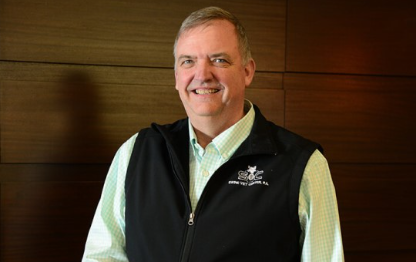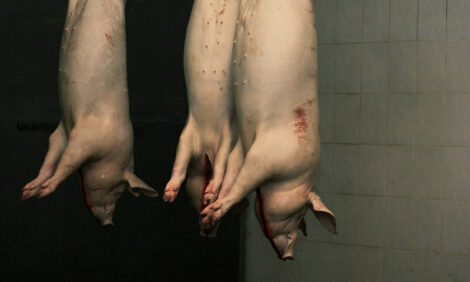



Swine veterinarian shares lessons learned from COVID-19 disruptions
Nothing in his lifetime could have prepared Paul Yeske, DVM, of Swine Vet Center, for the painful fallout from COVID-19 that hit the clinic and its clients.
In early April 2020, major packing plants taking most of their clients’ hogs started shutting down. At one point, processing capacity dropped 45%, with most plant closures occurring in Minnesota, South Dakota and Iowa as well as other plants slowing down and reducing capacity.
“Plant closures were one of those things we didn’t see coming,” related Yeske, whose clinic is located in St. Peter, Minnesota. “We were in the middle of it. It had a major impact on our producers and clients.”
Yeske and his colleagues devised contingency plans for handling a glut of market-weight pigs with no place to go. Fortunately, many others including producers jumped in to help. Yeske discussed the harrowing situation and outcomes during a talk at the 2020 Leman Swine Conference held virtually in mid-September.
Penalty for efficiency
“The industry was always rewarded for building better efficiency. But we soon learned there was a penalty when that comes apart,” Yeske explained. “There was no room for problems to develop. [It was like] being on an escalator and the people at the top aren’t moving away and you are trapped. I think everybody this spring felt that pressure and felt trapped.”
The first step before closures occurred was slowing down pig growth. Producers warmed up the temperatures in buildings, tightened up feeders, added fiber to diets and made other recommended nutritional changes.
But drastic action was needed to handle the massive loss of packing capacity as plant shutdowns occurred. Depopulation and disposal were needed to handle the overflow of pigs.
Depopulation lessons
In the past, Yeske said he participated in exercises for handling foreign animal-disease outbreaks, which involved discussions about mass depopulation. But it didn’t fully prepare him for this event.
“Like many other things, it’s much different to do it than to plan and talk about it,” he said. “We really learned it takes a lot of logistics. Some of these systems had to act like a packing plant — we were getting rid of that many pigs. We started out using traditional methods…but our veterinarians were saying we had to come up with a better plan.
“The challenge is how to do mass depopulation [in] the best way to euthanize the pig and keep people safe,” he added. “The silver lining out of this is we now have better methods for mass depopulation…we know what works and, more importantly, what doesn’t work.”
Some of the better options include the use of trucks and shipping containers with CO2 and ventilation shutdowns. Work on these options continues. For example, North Carolina State University is developing shipping containers with CO2 to handle mass depopulation.
Disposal of carcasses
Disposal was also a challenge with plants shut down, Yeske said. But because not everyone depopulated at the same time and there was also less restaurant waste, they were able to get most of the carcasses through rendering plants.
A large number of carcasses were still available to test the grind-and-compost method. Minnesota used two centralized locations for composting the carcasses.
“We did learn how to compost,” Yeske said. The grinding method really helped speed up the process by getting the compost to temperature faster, which will be important in a foreign animal-disease situation. It also requires less area to get it done.
Other lessons
Some hog farms with significant health issues used this crisis to depopulate. They also waited to repopulate when the market was more favorable. “I have never seen farms that were mothballed,” Yeske admitted.
“Some producers went through and only fed good-quality pigs and euthanized the bottom end,” he said. “Some aborted sows to make holes in production to allow farms to stabilize health and reduce numbers in the system.”
Yeske also learned untraditional markets can offer big help. “We were able to get pigs out of the system. Some smaller plants geared up. Local lockers are still booked for 6 to 12 months. Sale barns moved a lot of pigs. And university meat labs set up to do custom slaughter for food shelves.”
Figures from the Minnesota Pork Producers show the untraditional markets moved a lot of hogs. About 250,000 pigs were taken out of the system and given away. Another 350,000 pigs were euthanized.
Future preparation
“What do we do in the future so we don’t have to face this again?” Yeske asked. “We talk about building slack capacity in production systems, but it’s too difficult, particularly with economics today. There is some discussion with packing plants about building slack capacity, but they are built around efficiency as well.”
Instead, Yeske suggested using a COVID-type situation to make the industry healthier. He looks back and wishes the industry had taken advantage of the shutdowns to improve herd health. In the future, the industry needs to help itself and set up funds like what they did with the Swine Health Information Center. Funding will help the industry be ready to act when unexpected situations occur and not left trying to react in the face of the battle.
“There would be opportunities to capture this and come out as a healthier industry,” he said. “Unfortunately, I think we missed that opportunity [with COVID-19].
“As we know from the past, those willing to adapt will survive,” Yeske continued. “There will be a new normal as we go forward. And we have to find some funding to help us go through these things in the future…We have to remember we still live in one of the best places to raise pork.”






